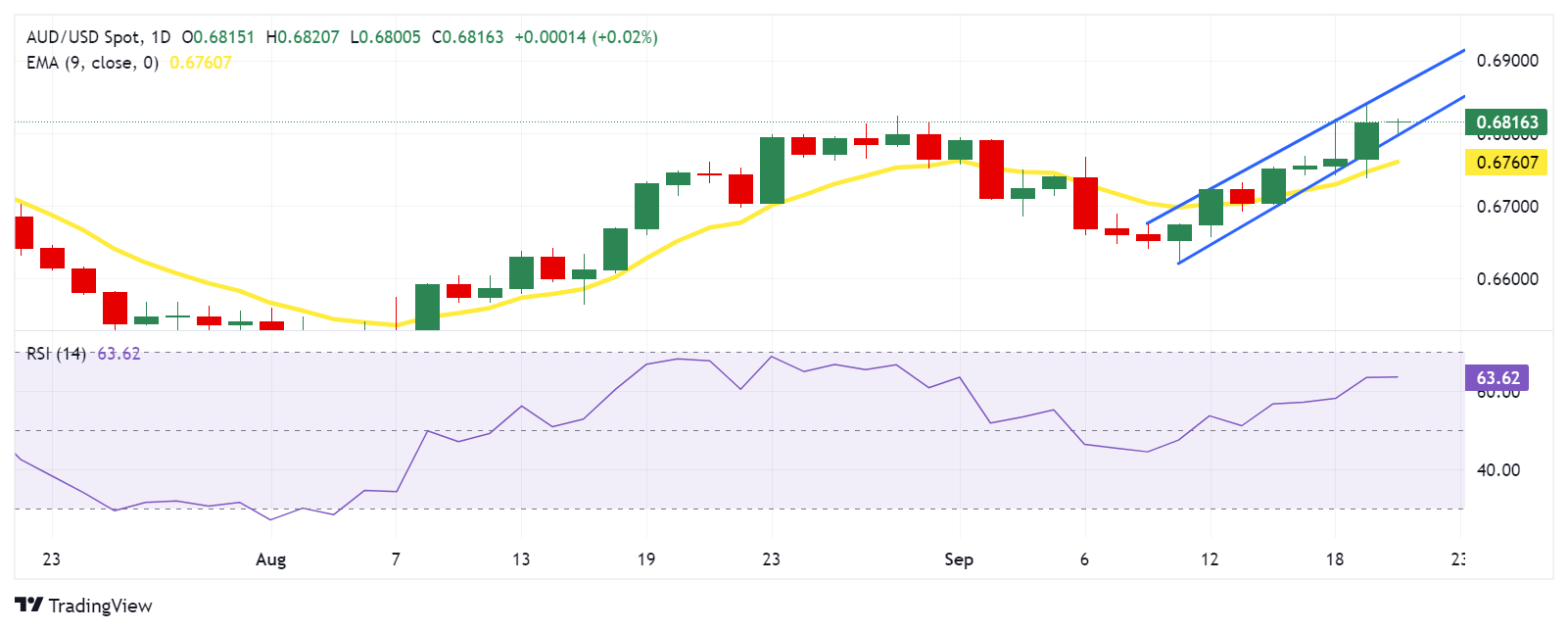Australian Dollar recovers losses following PBoC interest rates decision
- The Australian Dollar receives support against the US Dollar on central banks’ policy divergence.
- The PBoC decided to keep its one-year and five-year Loan Prime Rates unchanged at 3.35% and 3.85%, respectively.
- The US Dollar struggles amid the rising likelihood of further rate cuts by the Federal Reserve in 2024.
The Australian Dollar (AUD) recovers its daily losses and extends its winning streak against the US Dollar (USD) following the interest rate decision by the People’s Bank of China (PBoC) on Friday. The PBoC opted to keep its one-year and five-year Loan Prime Rates (LPRs) unchanged at 3.35% and 3.85%, respectively. As close trade partners, any developments in the Chinese economy can significantly impact Australian markets.
The AUD/USD pair received support following Thursday’s labor market report and the Federal Reserve’s (Fed) 50 basis points (bps) interest rate cut on Wednesday. The divergence in monetary policy between the Reserve Bank of Australia’s (RBA) commitment to maintaining higher rates for longer and the Fed’s easing cycle is expected to impact the pair’s movement in the near term.
The US Dollar faces challenges amid growing expectations for further rate cuts by the US Federal Reserve by the end of 2024. The latest dot plot projections suggest a gradual easing cycle, with the median rate for 2024 revised down to 4.375% from the 5.125% forecast in June.
Fed Chair Jerome Powell commented on the aggressive rate cut, saying, “This decision reflects our growing confidence that, with the appropriate adjustments to our policy, we can maintain a strong labor market, support moderate economic growth, and bring inflation down to a sustainable 2% level.”
Daily Digest Market Movers: Australian Dollar rises against US Dollar on central banks’ policy divergence
- US Treasury Secretary Janet Yellen stated on Friday that the recent interest rate cut by the Federal Reserve is a very positive indicator for the US economy. According to Yellen, it demonstrates the Fed's confidence that inflation has significantly decreased and is moving toward the 2% target. Meanwhile, the job market continues to show strength.
- Australian Employment Change came in at 47.5K in August, down from 58.2K in July, but well above the consensus forecast of 25.0K. The Unemployment Rate remained steady at 4.2% in August, in line with both expectations and the previous month's figure, according to data released by the Australian Bureau of Statistics (ABS).
- The Federal Open Market Committee (FOMC) lowered the federal funds rate to a range of 4.75% to 5.0%, marking the Fed’s first rate cut in over four years. This move signals the Fed’s commitment to safeguarding the labor market and steering the economy away from any signs of recession.
- Fed policymakers updated their quarterly economic forecasts, increasing the median projection for unemployment to 4.4% by the end of 2024, up from the 4% estimate made in June. They also raised their long-term forecast for the federal funds rate from 2.8% to 2.9%.
- Economists at Goldman Sachs and Citi have lowered their 2024 GDP growth forecasts for China to 4.7%, below Beijing's target of approximately 5.0%. SocGen describes the scenario as a "downward spiral," while Barclays refers to it as "from bad to worse" and a "vicious cycle." Morgan Stanley has also warned that "things could get worse before they get better," according to a Reuters report.
- China's economy showed signs of weakness in August, characterized by a continued slowdown in industrial activity and falling real estate prices. This situation has prompted increasing pressure on Beijing to enhance spending to stimulate demand, as reported by the National Bureau of Statistics on Saturday, according to Business Standard.
- Reserve Bank of Australia (RBA) Governor Michele Bullock emphasized that it is premature to consider rate cuts given the persistently high inflation. Additionally, RBA Assistant Governor Sarah Hunter noted that while the labor market remains tight, wage growth seems to have peaked and is expected to slow further.
Technical Analysis: Australian Dollar holds a position within the rising wedge near 0.6800
The AUD/USD pair trades near 0.6810 on Friday. Technical analysis of the daily chart shows that the pair is moving upward within the rising wedge pattern, signaling a strengthening of a bullish bias. Additionally, the 14-day Relative Strength Index (RSI) moves toward the 70 mark, indicating an ongoing bullish trend for the pair.
Regarding the upside, the AUD/USD pair may explore the region around the upper boundary of the rising wedge at the 0.6870 level. A breakthrough above the rising wedge could support the pair to test the psychological level of 0.6900.
On the downside, the AUD/USD pair is testing the lower boundary of the rising wedge around the level of 0.6800. A break below this level could pressure the pair to test the nine-day Exponential Moving Average (EMA) at 0.6760, with the next support at the psychological level of 0.6700.
AUD/USD: Daily Chart

Australian Dollar PRICE Today
The table below shows the percentage change of Australian Dollar (AUD) against listed major currencies today. Australian Dollar was the strongest against the Canadian Dollar.
| USD | EUR | GBP | JPY | CAD | AUD | NZD | CHF | |
|---|---|---|---|---|---|---|---|---|
| USD | -0.03% | -0.05% | -0.31% | 0.00% | -0.04% | -0.08% | -0.16% | |
| EUR | 0.03% | -0.03% | -0.27% | 0.01% | -0.02% | -0.04% | -0.13% | |
| GBP | 0.05% | 0.03% | -0.25% | 0.07% | 0.03% | -0.01% | -0.08% | |
| JPY | 0.31% | 0.27% | 0.25% | 0.31% | 0.25% | 0.22% | 0.16% | |
| CAD | -0.01% | -0.01% | -0.07% | -0.31% | -0.05% | -0.08% | -0.15% | |
| AUD | 0.04% | 0.02% | -0.03% | -0.25% | 0.05% | -0.01% | -0.12% | |
| NZD | 0.08% | 0.04% | 0.00% | -0.22% | 0.08% | 0.01% | -0.07% | |
| CHF | 0.16% | 0.13% | 0.08% | -0.16% | 0.15% | 0.12% | 0.07% |
The heat map shows percentage changes of major currencies against each other. The base currency is picked from the left column, while the quote currency is picked from the top row. For example, if you pick the Australian Dollar from the left column and move along the horizontal line to the US Dollar, the percentage change displayed in the box will represent AUD (base)/USD (quote).
Australian Dollar FAQs
One of the most significant factors for the Australian Dollar (AUD) is the level of interest rates set by the Reserve Bank of Australia (RBA). Because Australia is a resource-rich country another key driver is the price of its biggest export, Iron Ore. The health of the Chinese economy, its largest trading partner, is a factor, as well as inflation in Australia, its growth rate and Trade Balance. Market sentiment – whether investors are taking on more risky assets (risk-on) or seeking safe-havens (risk-off) – is also a factor, with risk-on positive for AUD.
The Reserve Bank of Australia (RBA) influences the Australian Dollar (AUD) by setting the level of interest rates that Australian banks can lend to each other. This influences the level of interest rates in the economy as a whole. The main goal of the RBA is to maintain a stable inflation rate of 2-3% by adjusting interest rates up or down. Relatively high interest rates compared to other major central banks support the AUD, and the opposite for relatively low. The RBA can also use quantitative easing and tightening to influence credit conditions, with the former AUD-negative and the latter AUD-positive.
China is Australia’s largest trading partner so the health of the Chinese economy is a major influence on the value of the Australian Dollar (AUD). When the Chinese economy is doing well it purchases more raw materials, goods and services from Australia, lifting demand for the AUD, and pushing up its value. The opposite is the case when the Chinese economy is not growing as fast as expected. Positive or negative surprises in Chinese growth data, therefore, often have a direct impact on the Australian Dollar and its pairs.
Iron Ore is Australia’s largest export, accounting for $118 billion a year according to data from 2021, with China as its primary destination. The price of Iron Ore, therefore, can be a driver of the Australian Dollar. Generally, if the price of Iron Ore rises, AUD also goes up, as aggregate demand for the currency increases. The opposite is the case if the price of Iron Ore falls. Higher Iron Ore prices also tend to result in a greater likelihood of a positive Trade Balance for Australia, which is also positive of the AUD.
The Trade Balance, which is the difference between what a country earns from its exports versus what it pays for its imports, is another factor that can influence the value of the Australian Dollar. If Australia produces highly sought after exports, then its currency will gain in value purely from the surplus demand created from foreign buyers seeking to purchase its exports versus what it spends to purchase imports. Therefore, a positive net Trade Balance strengthens the AUD, with the opposite effect if the Trade Balance is negative.

